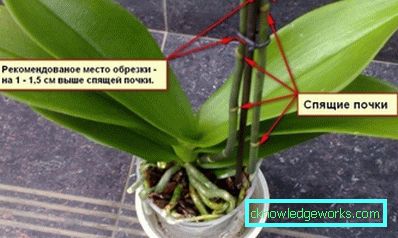How to correctly trim the orchid after flowering
How to correctly trim the orchid after flowering.
The flowering of a beautiful orchid can last up to six months, but, like any flower, its peduncle then begins to wither. Proper assessment of the state of the plant during this period and pruning of the peduncle will further affect the health of the orchid and the duration of the next flowering.
Drying spike.
After the orchid peduncle has faded, it can continue its growth or dry out. It is advisable not to cut off the drying flower spike immediately, because during this period the plant will begin to pull out all the remaining nutrients that will be needed for the further development of the orchid. When the peduncle is completely yellow or completely dry, it can be removed, leaving a stump about 2-2.5 cm in size.
Important: When withering old flower spike can change color not only to the traditional brown or yellow, but also to purple or red. This is a normal phenomenon, which does not indicate a disease of the plant.
Buds on the old peduncle: the rules of pruning.
Phalaenopsis has a meristem covered with protective scales on each peduncle, which are also called sleeping buds. Their number depends on the length of the peduncle, usually about 3-4 pieces. Each of the buds can theoretically one day go into growth and form a baby or lateral peduncle.
If you want to get re-flowering on the old peduncle, try to cut it a little above the location of the meristem, about 1-3 cm above them. But remember that trimming the peduncle alone does not guarantee that the buds will wake up. So, the trimmed peduncle about a year can remain without flowering and eventually dry out from old age.
In addition, old flower stalks often impede the development of new ones, because the orchid gives all its vitality to maintain the former.
When deciding not to trim off the flowering peduncle and hoping to wait for the kidneys to wake up, keep in mind that your plant should have a certain tendency to form babies, for example, to inherit it from orchids such as Phalaenopsis equestris, Phalaenopsis cornu-cervi or Phalaenopsis pulchra. These plants give birth to on each peduncle. There are also such natural species that even when using growth hormones are difficult to force to give to the baby.
So that after flowering orchid gave new flower spike, you can reduce watering and use the method of temperature difference.
Remember that peduncles grow most readily in temperate, and children - in a humid and warm climate. So, containing an orchid at 17-18C, with a probability of 90% you will receive a peduncle, and at a temperature of 25C - baby.

Cut handling.
Most flower growers, cutting off the old flower spike, do not process the cut. But if you doubt the hygiene of the room or the window sill on which the orchid lives, sprinkle it with charcoal powder. Before cutting the peduncle, be sure to disinfect the instrument.
